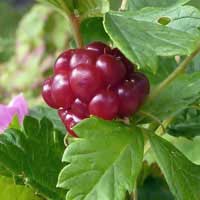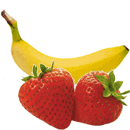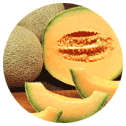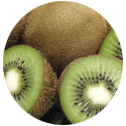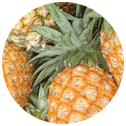Fruits Home
 Full List of Fruits
Full List of Fruits  Broad-leaf Bramble
Broad-leaf BrambleBroad-leaf Bramble plant
![]() Introduction of Broad-leaf Bramble
Introduction of Broad-leaf Bramble
Scientific name - Rubus moluccanus
The Brambl's leaves are mostly oval or heart shaped about 2 to 15cm long and 3 to 10cm wide. The underside of the leaves features hairy part and each leaf contains about 3 to 5 lobes. The flowers are a beautiful pinkish red or white and always flower in bundles. These flowers later turn to vibrant red fruits. Each variety varies in color and flavor. The Molucca Bramble fruit is mostly a deep red, raspberry like appearance and color. This tasty fruit is edible and is widely used in Jams, jellies and sauces. It is also consumed raw without any modifications.
![]() Nutritional Value of Broad-leaf-Bramble
Nutritional Value of Broad-leaf-Bramble
| Principle | Nutrient Value | Percentage of RDA |
|---|---|---|
| Energy | 43 Kcal | 2% |
| Carbohydrates | 9.61 g | 7% |
| Protein | 1.39 g | 2% |
| Total Fat | 0.49 g | 2% |
| Cholesterol | 0 mg | 0% |
| Dietary Fiber | 5.3 g | 14% |
| Vitamins | ||
| Folates | 25 µg | 6% |
| Niacin | 0.646 mg | 4% |
| Pantothenic acid | 0.276 mg | 5.5% |
| Pyridoxine | 0.030 mg | 2% |
| Thiamin | 0.020 IU | 2% |
| Vitamin A | 214 IU | 7% |
| Vitamin C | 21 mg | 35% |
| Vitamin E | 1.17 mg | 8% |
| Vitamin K | 19.8 µg | 16.5% |
![]() Health Benefits of Broad-leaf Bramble
Health Benefits of Broad-leaf Bramble
On a medical basis it has been used to treat bed wetting among children. It is grown in large areas than in small gardens. Requires a ton of water and the soil also needs to be well drained. If maintained well with regards to pruning, it responds well and will grow beautifully in your desired dimensions. Tea made from the leaves is used to treat diarrhea. The roots are used to treat dysentery and other internal issues in Malaysia. In certain parts the leaves are chewed along with salt and the chewed leaves are applied on sore parts of the skin. It is said to have a healing effect on the skin. Stem sap is also said to treat diarrhea and dysentery. Sap from a young stem is still used to this day to induce labor. The roots are used to treat cold and are also used as a blood tonic especially in parts of Thailand.
Like most berries the seeds are best sown in the autumn. These seeds however require some stratification. If the seeds have been stored they need about a month's stratification in 3 ? C. If sown at the right time they need to grow in a cold frame. Prick out the seeds when they are big enough and replant them onto their permanent spot the following spring.
Broad-leaf Bramble has a number of uses. It can be used in the garden as a low-maintenance hedge or as a ground cover. It will spread quickly, so it is important to keep it contained. It is also a great addition to wildlife gardens and provides food and shelter for birds, insects, and other wildlife.
The edible fruits of Broad-leaf Bramble can be eaten raw, cooked into jams, jellies, and juices, or used in baking. They are high in vitamins and minerals, including Vitamin C, iron, and magnesium. They also contain a variety of antioxidants which can help to protect against certain diseases.
Broad-leaf Bramble is also used medicinally. The leaves and berries have been used to treat a variety of ailments, including skin irritations, digestive issues, and even fever. They are also said to have anti-inflammatory properties, making them a good choice for treating conditions such as arthritis.Broad-leaf Bramble is also used in landscaping and as an ornamental plant. Its bright green foliage and vibrant red berries make it an attractive addition to any garden. It is also tolerant of a variety of soil types and can be grown in either full sun or partial shade.The roots and stems of Broad-leaf Bramble can also be used to make a variety of crafts. The stems can be dried and used to make wreaths, while the roots can be used to make baskets and other decorative items. The leaves can also be used to make tea, while the berries can be used to make dyes or ink.
![]() Fertilization of Broad-leaf Bramble
Fertilization of Broad-leaf Bramble
Fertilization of broad-leaf bramble is an important part of its cultivation and maintenance. The most important nutrient for broad-leaf bramble is nitrogen. This can be added to the soil in the form of organic matter such as compost, or with a nitrogen-based fertilizer. Nitrogen helps the plant to develop strong, healthy growth and abundant flowers and fruits. Phosphorus is also important for broad-leaf bramble. Phosphorus helps the plant to develop strong roots and stems, which are essential for good fruiting. It also helps the plant to resist disease and pests. Phosphorus can be added to the soil in the form of a fertilizer or with organic matter such as bone meal or rock phosphate.
Potassium is another important nutrient for broad-leaf bramble. Potassium helps the plant to develop strong, healthy leaves and flowers and encourages fruiting. It also helps the plant to resist disease and pests. Potassium can be added to the soil in the form of a fertilizer or with organic matter such as wood ash. In addition to the major nutrients, broad-leaf bramble also requires a range of minor nutrients such as calcium, magnesium, iron, copper, and zinc. These nutrients can be added to the soil in the form of a fertilizer or with organic matter such as kelp or rock dust. Broad-leaf bramble should be fertilized in early spring, after the last frost, and then again in mid-summer. The amount of fertilizer required will depend on the size and age of the plant, as well as the type of soil it is in.Fertilization and pruning are essential for the health and productivity of broad-leaf bramble. With the right care and attention, the plant will reward you with a plentiful harvest of delicious blackberries.













